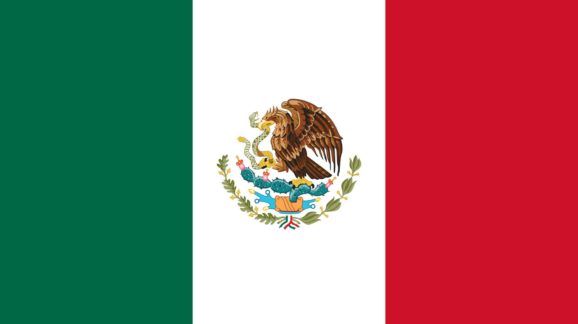Trump Threatens up to 25 Percent Tariff on Mexican Goods, Jeopardizes NAFTA/USMCA

 Things have been moving quickly on President Trump’s top legislative priority, the NAFTA/USMCA trade agreement. The key was rescinding steel and aluminum tariffs against Canada and Mexico. On Wednesday, Canadian Prime Minister Justin Trudeau moved to introduce the agreement to Canada’s legislature for ratification, prompting a Thursday visit from Vice President Mike Pence. Also on Thursday, Mexican President Andres Manuel Lopez Obrador introduced NAFTA/USMCA in Mexico’s Senate. He is requesting that the body, on recess until September, hold a special session to ratify it.
Things have been moving quickly on President Trump’s top legislative priority, the NAFTA/USMCA trade agreement. The key was rescinding steel and aluminum tariffs against Canada and Mexico. On Wednesday, Canadian Prime Minister Justin Trudeau moved to introduce the agreement to Canada’s legislature for ratification, prompting a Thursday visit from Vice President Mike Pence. Also on Thursday, Mexican President Andres Manuel Lopez Obrador introduced NAFTA/USMCA in Mexico’s Senate. He is requesting that the body, on recess until September, hold a special session to ratify it.
Within hours of Lopez Obrador’s announcement, President Trump may have torpedoed his own agreement. Shortly after markets closed, he threatened, via Twitter, a new tariff against Mexico that would dwarf the steel and aluminum tariffs:
1/2: On June 10th, the United States will impose a 5% Tariff on all goods coming into our Country from Mexico, until such time as illegal migrants coming through Mexico, and into our Country, STOP. The Tariff will gradually increase until the Illegal Immigration problem is remedied,..
2/2:….at which time the Tariffs will be removed. Details from the White House to follow.
On July 1, the 5 percent tariff would rise to 10 percent. It would then rise by an additional 5 percent at the beginning of each month until reaching 25 percent on October 1. It would remain there until President Trump is satisfied with Mexico’s immigration policies. He did not set specific criteria for Mexico to meet. And as mentioned earlier, Mexico’s Senate is out of session until September. But the administration’s statement indicates that this threat isn’t entirely about immigration (capitalization of “tariff” and typewriter-era extra spacing between sentences in original):
If Mexico fails to act, Tariffs will remain at the high level, and companies located in Mexico may start moving back to the United States to make their products and goods. Companies that relocate to the United States will not pay the Tariffs or be affected in any way.
By way of context, this tariff would be nearly twice as large as the recent 25 percent tariff on $200 billion of Chinese goods. Mexico annually exports roughly $346.5 billion of goods to the United States.
NAFTA and the NAFTA 2.0/USMCA both require near-zero tariffs among the three member countries. Trump has invoked the Jimmy Carter-era 1977 International Emergency Economic Powers Act as legal authority for the tariffs, claiming that that bill’s emergency powers supersede possible NAFTA violations.
As I’ve mentioned before, Trump has a habit of using dramatic last-minute threats as a negotiating tactic. Sometimes he follows through, as with the recent 25 percent tariff on $200 billion of Chinese goods. Sometimes he withdraws, as he did with a threat to close the entire U.S.-Mexican border, and an April threat of a 25 percent tariff on Mexican-assembled automobiles—which are often made largely of U.S.-made parts.
For obvious reasons, a new tariff against Mexico will not make its government more likely to ratify NAFTA/USMCA. Tariffs are usually met with retaliatory tariffs, not the policy action Trump wants. The U.S. economy is risking yet another instance of double damage from President Trump’s announcement—once from his tariffs, and again from retaliatory tariffs.
Further complicating matters, Mexican President Lopez Obrador largely shares Trump’s negative view of free trade. His support of NAFTA/USMCA is not deeply held. His going along with the agreement is largely a kindness to his predecessor, Enrique Peña-Nieto, who negotiated the agreement and signed it on his final day in office. Lopez Obrador’s NAFTA/USMCA support is easily lost, and this tariff gives him an easy out.
The tariff also complicates matters in America. Also on Thursday, President Trump issued a Statement of Administrative Action. This opens a 30-day waiting period, after which Trump can send NAFTA/USMCA to Congress at any time for a mandatory ratification vote within a set period (Politico has a handy timeline). Members from both parties opposed the steel and aluminum tariffs, and they will likely oppose the new tariff, which is potentially much larger. If Congress is required to vote, it may well vote no due to the new Mexico tariffs.
Democrats already hold the upper hand in negotiations due to the administration’s high prioritization of a low-stakes agreement; USMCA contains no major changes to trade policy. Even without Trump’s tariff threat, they could hold up the agreement to add trade-unrelated provisions to benefit favored labor and environmental constituencies. Or they could condition ratification on a more important matter, such as must-pass appropriations bills or other Democratic policy priorities such as health care or the minimum wage.
A new tariff is Trump giving Democrats free ammunition to hold up not just NAFTA/USMCA, but other administration priorities as well.
We’ll find out by June 10th if Trump walks back a major economic and political mistake, or goes through with it.